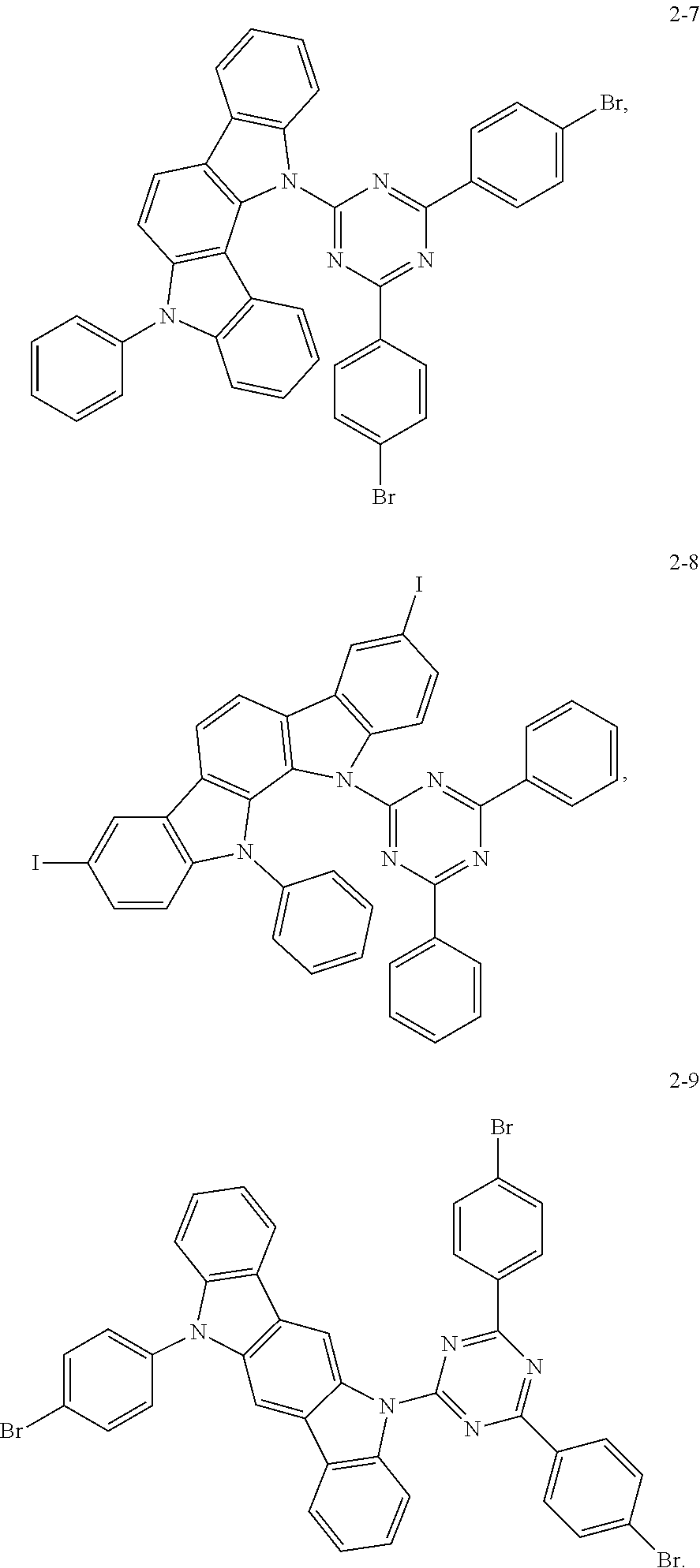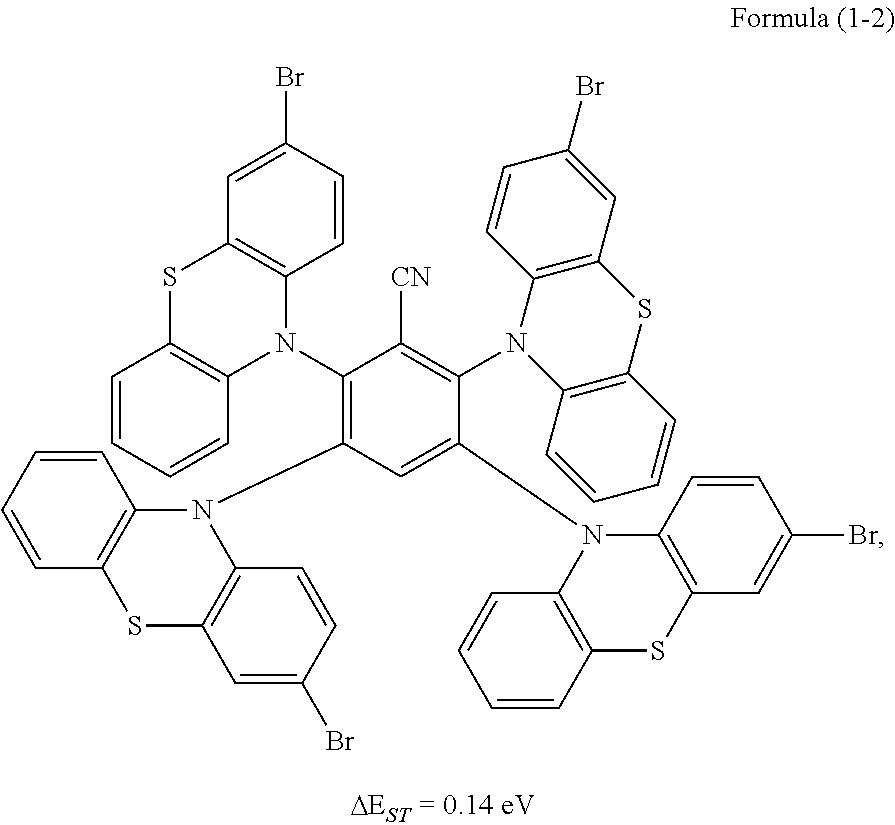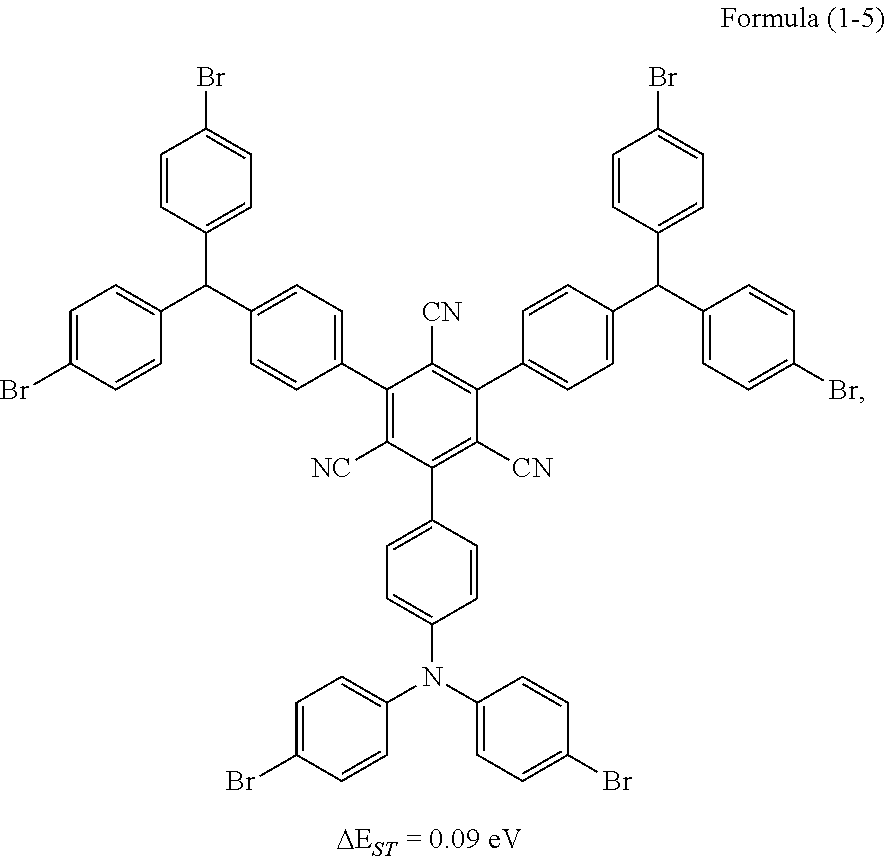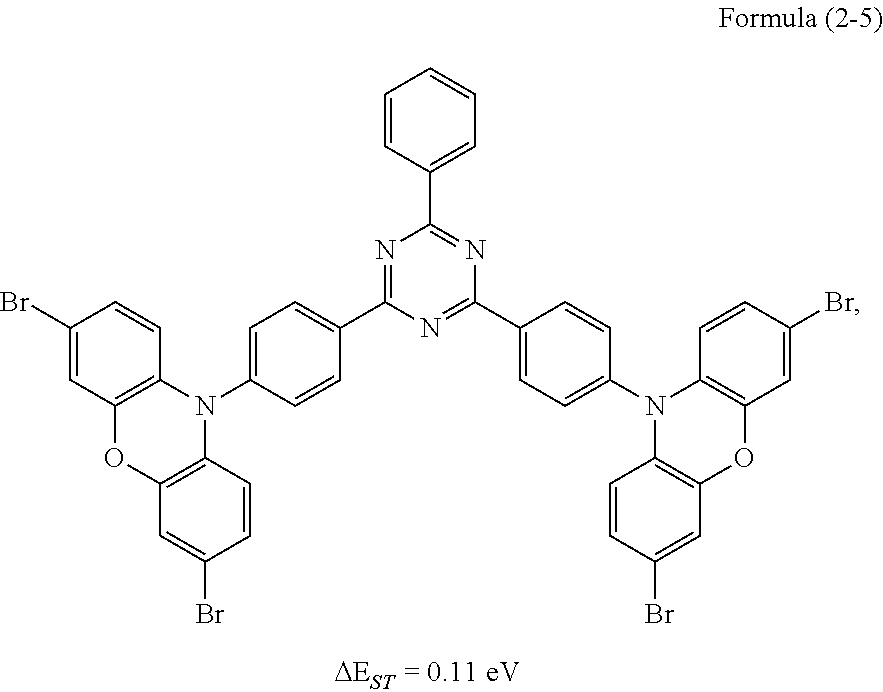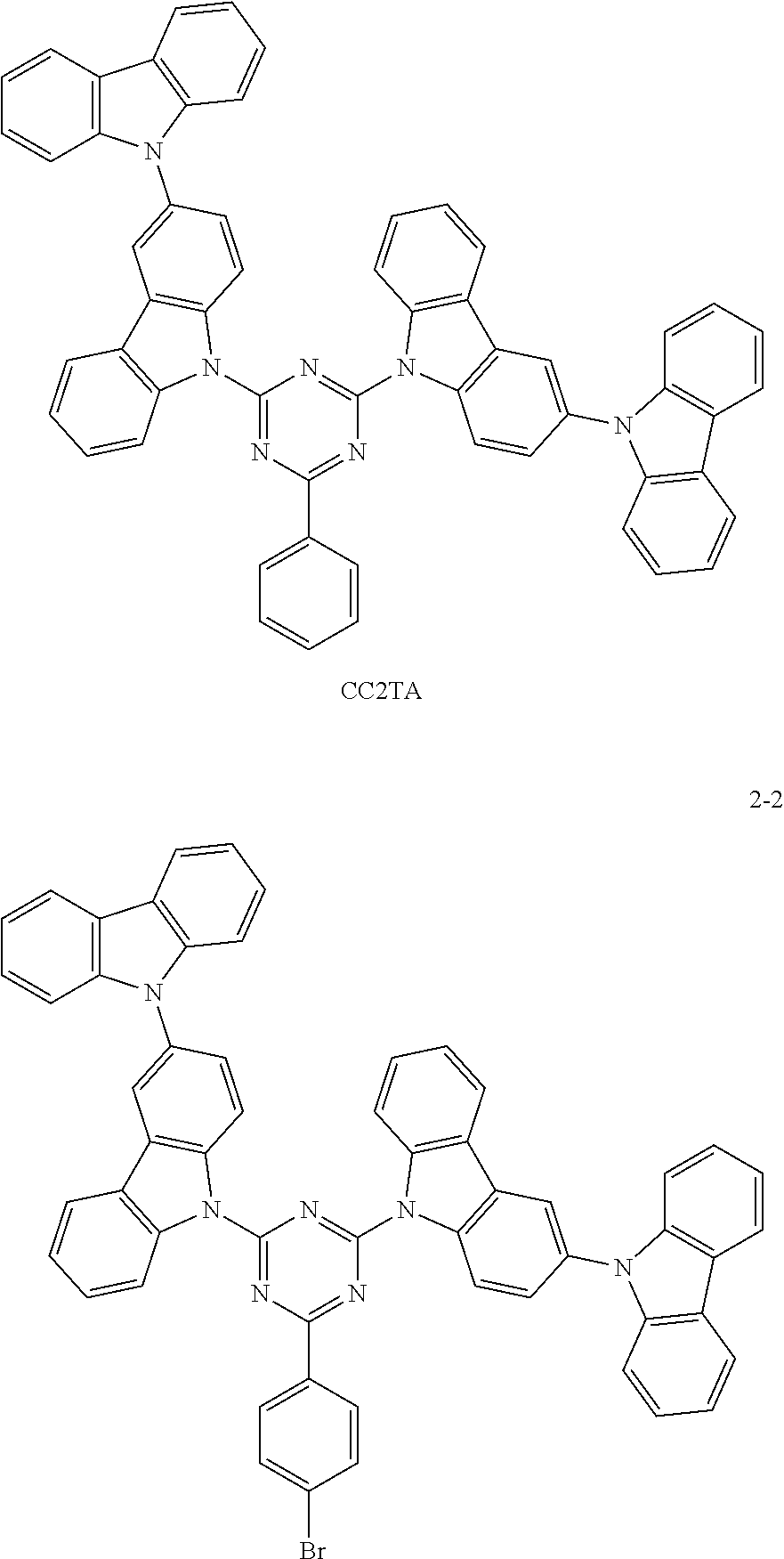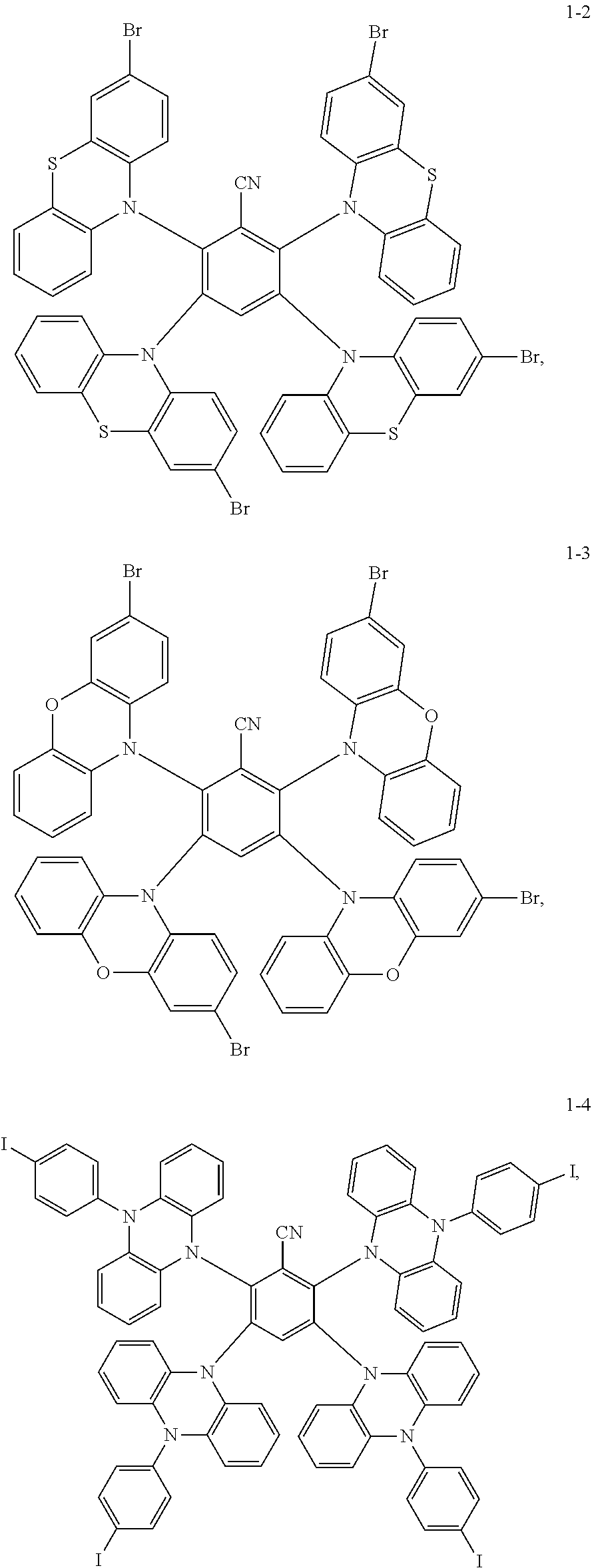Thermally activated delayed fluorescence material and application thereof in organic electroluminescence device
Duan , et al. Sep
U.S. patent number 10,770,661 [Application Number 15/770,730] was granted by the patent office on 2020-09-08 for thermally activated delayed fluorescence material and application thereof in organic electroluminescence device. This patent grant is currently assigned to KUNSHAN GP-VISIONOX OPTO-ELECTRONICS CO., LTD., TSINGHUA UNIVERSITY. The grantee listed for this patent is KUNSHAN GO-VISIONOX OPTO-ELECTRONICS CO., LTD., TSINGHUA UNIVERSITY. Invention is credited to Lian Duan, Song Liu, Dongdong Zhang, Fei Zhao.









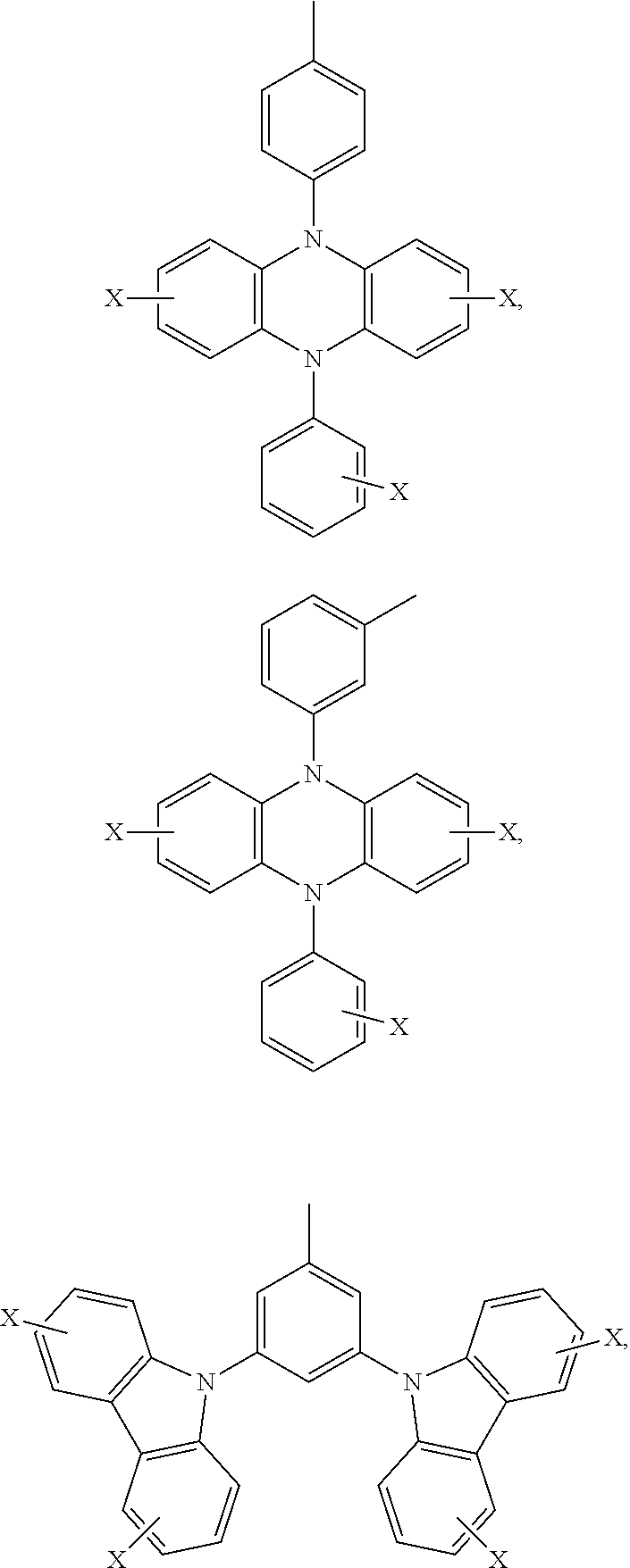


View All Diagrams
| United States Patent | 10,770,661 |
| Duan , et al. | September 8, 2020 |
Thermally activated delayed fluorescence material and application thereof in organic electroluminescence device
Abstract
The present invention discloses a thermally activated delayed fluorescence material and application thereof in an organic electroluminescence device. The thermally activated delayed fluorescence material is a compound having the general structure of Formula I or Formula II: ##STR00001## In Formula I and Formula II, R.sub.1 is a cyano, p is 1, 2 or 3, q is 1, 2 or 3, m is 1 or 2, n is 1 or 2, Ar.sub.1 is a phenyl substituted with one or more groups selected from C.sub.1-6 alkyl, methoxy, ethoxy, or phenyl, Ar.sub.2 and Ar.sub.3 are selected from the following groups: ##STR00002## ##STR00003## ##STR00004## ##STR00005## and X is bromine or iodine. The present invention further discloses application of the thermally activated delayed fluorescence material as a host material or a luminescent dye of a luminescent layer of an organic electroluminescence device.
| Inventors: | Duan; Lian (Beijing, CN), Zhang; Dongdong (Beijing, CN), Liu; Song (Beijing, CN), Zhao; Fei (Beijing, CN) | ||||||||||
|---|---|---|---|---|---|---|---|---|---|---|---|
| Applicant: |
|
||||||||||
| Assignee: | KUNSHAN GP-VISIONOX
OPTO-ELECTRONICS CO., LTD. (Kunshan, CN) TSINGHUA UNIVERSITY (Beijing, CN) |
||||||||||
| Family ID: | 1000005044299 | ||||||||||
| Appl. No.: | 15/770,730 | ||||||||||
| Filed: | November 30, 2016 | ||||||||||
| PCT Filed: | November 30, 2016 | ||||||||||
| PCT No.: | PCT/CN2016/107913 | ||||||||||
| 371(c)(1),(2),(4) Date: | April 24, 2018 | ||||||||||
| PCT Pub. No.: | WO2017/101675 | ||||||||||
| PCT Pub. Date: | June 22, 2017 |
Prior Publication Data
| Document Identifier | Publication Date | |
|---|---|---|
| US 20190074447 A1 | Mar 7, 2019 | |
Foreign Application Priority Data
| Dec 18, 2015 [CN] | 2015 1 0957493 | |||
| Current U.S. Class: | 1/1 |
| Current CPC Class: | C07D 403/14 (20130101); H01L 51/0072 (20130101); C07D 279/28 (20130101); C07D 487/04 (20130101); C07D 403/10 (20130101); H01L 51/5012 (20130101); H01L 51/0059 (20130101); C07D 241/48 (20130101); C07D 265/38 (20130101); H01L 51/0067 (20130101); C07D 251/24 (20130101); C07D 417/14 (20130101); C07D 413/14 (20130101); C09K 11/06 (20130101); H01L 51/50 (20130101); C07D 209/88 (20130101); H01L 51/5072 (20130101); H01L 51/5088 (20130101); H01L 51/5056 (20130101) |
| Current International Class: | H01L 51/50 (20060101); C07D 403/14 (20060101); C07D 251/24 (20060101); C07D 487/04 (20060101); C09K 11/06 (20060101); C07D 209/88 (20060101); C07D 265/38 (20060101); C07D 279/28 (20060101); C07D 241/48 (20060101); C07D 413/14 (20060101); H01L 51/00 (20060101); C07D 403/10 (20060101); C07D 417/14 (20060101) |
References Cited [Referenced By]
U.S. Patent Documents
| 9815940 | November 2017 | Eckes et al. |
| 2016/0181545 | June 2016 | Stoessel et al. |
| 102702132 | Oct 2012 | CN | |||
| 102709485 | Oct 2012 | CN | |||
| 103012206 | Apr 2013 | CN | |||
| 104245785 | Dec 2014 | CN | |||
| 104277824 | Jan 2015 | CN | |||
| 104716268 | Jun 2015 | CN | |||
| 105602553 | Sep 2015 | CN | |||
| 105418533 | Mar 2016 | CN | |||
| 105418533 | May 2016 | CN | |||
| 105602553 | May 2016 | CN | |||
| 2 711 359 | Mar 2014 | EP | |||
| 2722359 | Apr 2014 | EP | |||
| 2851408 | Mar 2015 | EP | |||
| 3112439 | Jan 2017 | EP | |||
| 2013-256490 | Dec 2013 | JP | |||
| 2014-043541 | Mar 2014 | JP | |||
| 2014-172852 | Sep 2014 | JP | |||
| 2015-065225 | Apr 2015 | JP | |||
| 2015-179809 | Oct 2015 | JP | |||
| 10-2013-0062895 | Jun 2013 | KR | |||
| 201443028 | Nov 2014 | TW | |||
| 201542506 | Nov 2015 | TW | |||
| 2011070963 | Jun 2011 | WO | |||
| 2013/085285 | Jun 2013 | WO | |||
| 2013081088 | Jun 2013 | WO | |||
| 2014194971 | Dec 2014 | WO | |||
| 2015022835 | Feb 2015 | WO | |||
| 2015080183 | Jun 2015 | WO | |||
| 2015/129715 | Sep 2015 | WO | |||
| 2015133353 | Sep 2015 | WO | |||
| 2015135625 | Sep 2015 | WO | |||
| 2015135626 | Sep 2015 | WO | |||
| 2016/174377 | Nov 2016 | WO | |||
| 2015/129715 | Mar 2017 | WO | |||
Other References
|
Kretzschmar et al., Development of Thermally Activated Delayed Fluorescence Materials with Shortened Emissive Lifetimes, The Journal of Organic Chemistry, vol. 80, No. 18, pp. 9126-9131 (Aug. 20, 2015). cited by examiner . Ishow et al., Multicolor Emission of Small Molecule-Based Amorphous Thin Films and Nanoparticles with a Single Excitation Wavelength, Chem. Mater., vol. 20, No. 21, pp. 6597-6599, (2008). cited by examiner . Thomas et al., Light-Emitting Carbazole Derivatives: Potential Electroluminescent Materials, J. Am. Soc.,vol. 123, No. 38, pp. 9404-9411 (2001). cited by examiner . Nakanotani, H., et al., "High-efficiency organic light-emitting diodes with fluorescent emitters" Nature communications, vol. 5, Article No. 4016, pp. 1-26 (May 30, 2014). cited by applicant . Yue-Qin, P., et al., "Synthesis and Photovoltaic Properties od D-Pie-A Type Conjugated Polymers," Journal of Functional Polymers, vol. 27 , No. 2, pp. 129-137 (Jun. 2014) (English Abstract). cited by applicant . M Kim et. al., "Simultaneous improvement of emission color, singlet-triplet energy gap, and quantum efficiency of blue thermally activated delayed fluorescent emitters using a 1-carbazolylcarbazole based donor", Chemical Communications, vol. 52, Jul. 12, 2015, pp. 10032-10035. cited by applicant . W-L Tsai et. al., "A versatile thermally activated delayed fluorescence emitter for both highly efficient doped and non-doped organic light emitting devices", Chemical Communications, vol. 51, Jul. 20, 2015, pp. 13662-13665. cited by applicant . D. R. Lee et. al., "Design Strategy for 25% External Quantum Efficiency in Green and Blue Thermally Activated Delayed Fluorescent Devices", Advanced Materials, vol. 27, Aug. 26, 2015, pp. 5861-5867. cited by applicant . CN Office Action in application No. 201510957493.2 dated Jul. 17, 2019. cited by applicant . Andreas Kretzschmar et. al., "Development of Thermally Activated Delayed Fluorescence Materials with Shortened Emissive Lifetimes", The Journal of Organic Chemistry, vol. 80, Aug. 20, 2015, pp. 9126-9131. cited by applicant . CN Office Action in application No. 2018-524282 dated May 28, 2019. cited by applicant. |
Primary Examiner: Rao; Deepak R
Attorney, Agent or Firm: Maschoff Brennan
Claims
The invention claimed is:
1. A thermally activated delayed fluorescence material, wherein the thermally activated delayed fluorescence material is a compound having a structure shown in formulas 1-2 to 1-5: ##STR00038## ##STR00039##
2. An organic electroluminescence device, comprising a luminescent layer, wherein the luminescent layer comprises a host material and a luminescent dye doped in the host material, and one of the host material and the luminescent dye is the thermally activated delayed fluorescence material according to claim 1.
3. The organic electroluminescence device according to claim 2, wherein the luminescent dye is the thermally activated delayed fluorescence material, the luminescent dye accounts for 0.5 wt %-10 wt % of the luminescent layer.
4. The organic electroluminescence device according to claim 2, wherein the luminescent dye is the thermally activated delayed fluorescence material, the luminescent dye accounts for 5 wt % of the luminescent layer.
5. The organic electroluminescence device according to claim 2, wherein the luminescent dye is the thermally activated delayed fluorescence material, the organic electroluminescence device comprises an anode, a hole transport layer, a luminescent layer, an electron transport layer, and a cathode, which are successively deposited on a substrate and are laminated.
6. The organic electroluminescence device according to claim 5, wherein the anode and the hole transport layer has a hole injection layer disposed therebetween.
7. The organic electroluminescence device according to claim 2, wherein the host material is the thermally activated delayed fluorescence material, the luminescent dye accounts for 1 wt %-10 wt % of the luminescent layer.
8. The organic electroluminescence device according to claim 2, wherein the luminescent dye is the thermally activated delayed fluorescence material according to claim 1.
9. An application of the thermally activated delayed fluorescence material according to claim 1, wherein the thermally activated delayed fluorescence material is used as a host material or a luminescent dye of a luminescent layer of an organic electroluminescence device.
Description
TECHNICAL FIELD
The present invention belongs to the field of materials, and particularly relates to a thermally activated delayed fluorescence material and application thereof in an organic electroluminescence device.
BACKGROUND ART
In the electroluminescence process of an organic electroluminescence device, luminescence occurs mainly due to the electronic transition of an organic luminescent material from an excited state to a ground state. At room temperature, luminescence generated by the electronic transition from a triplet excited state back to the ground state is extremely weak, most of the energy is lost in the form of heat, and luminescence is mainly generated by the electronic transition from a singlet excitation state to the ground state, and is called electroluminescence. Since the probability of the triplet excited state is three times that of the singlet excitation state, the equivalent of 75% of the energy is not used for luminescence. Making full use of the energy will effectively improve the luminescence efficiency of the organic electroluminescence device.
In order to make full use of the energy of the triplet excited state of a host material of a luminescent layer, various methods have been proposed. For example, by researching and developing an efficient phosphorescence doping dye and doping the phosphorescence doping dye into the host material, the triplet energy of the host material can be effectively transmitted to the phosphorescence doping dye, and then the phosphorescence doping dye generates phosphorescence, thereby allowing the energy of the triplet excited state of the host material of the luminescent layer to be effectively used. The organic electroluminescence device obtained by this method has high efficiency, but material synthesis requires precious metals such as ruthenium and platinum which are expensive. Another method is to utilize the intersystem crossing property of lanthanide compounds, namely intramolecular energy transfer, to transfer the triplet energy of the host material of the luminescent layer to the 4f energy level of lanthanide metal ions, and then luminescence and the like are achieved, but current devices are inefficient.
Thermally activated delayed fluorescence (TADF) is a quite popular scheme utilizing triplet exciton energy at present. For example, Adachi reported in his article a thermally activated delayed fluorescence material which has a small difference (.DELTA.E.sub.ST) between the triplet energy level (T.sub.1) and the singlet energy level (S.sub.1), in this way, triplet energy can be transmitted to the singlet energy level, and light is emitted through fluorescent radiation. Patent CN 102709485 A mentions that device efficiency is improved by doping a fluorescent dye in a thermal delay fluorescent host. In order to further improve energy transmission recombination efficiency, in the article "High-efficiency organic light-emitting diodes with fluorescent emitters" by Adachi et al. in Nature communications 2014, a wide-band-gap host doped TADF material is proposed as an auxiliary dye solution. However, in the process of charge recombination, part of the energy is directly compounded on a host, the host transmits the singlet energy to a dye, and the other part is compounded on an auxiliary dye. The structure reported in the article can not fully and effectively utilize the energy directly compounded on the host. At the same time, an ordinary host material is used, a band gap is wide, and required driving voltage is high.
However, the current TADF material has a short lifetime, and one of the reasons is that the lifetime of the triplet state is too long, and exciton quenching can be caused easily due to processes such as TPA. Therefore, the lifetime of a TADF device can be effectively increased by reducing the lifetime of triplet excitons.
Technical Problems
The technical problem to be solved by the present invention is that a TADF material in the prior art has a short lifetime.
Technical Solution
In order to solve the above technical problem, the present invention provides a novel TADF material. By introducing heavy atoms such as bromine or iodine into original TADF molecules, reverse intersystem crossing and intersystem crossing of the TADF material can be increased through the heavy atom effect, so that the lifetime of triplet excitons can be reduced, and ultimately the lifetime of a device can be increased.
The thermally activated delayed fluorescence material provided by the present invention is a compound having the general structure of Formula I or Formula II:
##STR00006##
In Formula I and Formula II, R.sub.1 is a cyano, p is 1, 2 or 3, q is 1, 2 or 3, m is 1 or 2, n is 1 or 2,
Ar.sub.1 is a phenyl substituted with one or more groups selected from C.sub.1-6 alkyl, methoxy, ethoxy, or phenyl,
Ar.sub.2 and Ar.sub.3 are selected from the following groups:
##STR00007## ##STR00008## ##STR00009## ##STR00010## and X is bromine or iodine.
Preferably, the thermally activated delayed fluorescence material is a compound having the following structure:
##STR00011## ##STR00012## ##STR00013## ##STR00014##
The present invention also provides application of the thermally activated delayed fluorescence material as a host material or a luminescent dye of a luminescent layer of an organic electroluminescence device.
The present invention further provides an organic electroluminescence device, comprising a luminescent layer, the luminescent layer comprises a host material and a luminescent dye doped in the host material, and the luminescent dye is the above thermally activated delayed fluorescence material. Preferably, the luminescent dye accounts for 0.5 wt %-10 wt % of the luminescent layer, and more preferably 5 wt %.
As a preferred technical solution, the organic electroluminescence device described above comprises an anode, a hole transport layer, a luminescent layer, an electron transport layer, and a cathode, which are successively deposited on a substrate and are laminated.
Preferably, a hole injection layer is further disposed between the anode and the hole transport layer.
The present invention further provides an organic electroluminescence device, comprising a luminescent layer, the luminescent layer comprises a host material and a luminescent dye doped in the host material, and the host material is the above thermally activated delayed fluorescence material.
Preferably, the luminescent dye accounts for 1 wt %-10 wt % of the luminescent layer.
Advantageous Effects
According to the TADF material provided by the invention, by introducing heavy atoms such as bromine or iodine into molecules, the lifetime of the triplet state of the TADF material is reduced, and efficiency roll-off is reduced, thereby increasing the lifetime of the organic electroluminescence device.
BRIEF DESCRIPTION OF THE DRAWINGS
FIG. 1 is the schematic diagram of the structure of an organic electroluminescence device of the present invention.
PREFERRED EMBODIMENTS OF THE INVENTION
The present invention will be further illustrated below by referring to the drawings and the special examples, to enable a person skilled in the art to better understand and implement the present invention, but the examples are not taken as limiting the present invention.
A thermally activated delayed fluorescence material provided in the invention is a compound having the general structure of Formula I or Formula II:
##STR00015##
In Formula I and Formula II, R.sub.1 is a cyano, p is 1, 2 or 3, q is 1, 2 or 3, m is 1 or 2, n is 1 or 2,
Ar.sub.1 is a phenyl substituted with one or more groups selected from C.sub.1-6 alkyl, methoxy, ethoxy, or phenyl,
Ar.sub.2 and Ar.sub.3 are selected from the following groups:
##STR00016## ##STR00017## ##STR00018## ##STR00019## and X is bromine or iodine.
According to the thermally activated delayed fluorescence material, by introducing heavy atoms such as bromine or iodine into original TADF molecules, reverse intersystem crossing and intersystem crossing of the TADF material can be increased through the heavy atom effect, so that the lifetime of triplet excitons can be reduced, and ultimately the lifetime of a device can be increased.
Specifically, the thermally activated delayed fluorescence material of the present invention is compounds having the following structures, and properties and preparation methods of the compounds are as follows:
##STR00020## Preparation Method:
Synthesis of the compound having the structure represented by Formula (1-1): in the nitrogen range, 3-bromocarbazole (5 mmol) is dissolved in 2 mL of anhydrous THF, then sodium hydride (5 mmol) is added, and the mixture is stirred at room temperature for 30 minutes; subsequently, 1,2-dicyano-4,5-difluorobenzene (1 mmol) is added to a reaction flask and stirring is continued for 1 hour; finally, 2 mL of cold water is added to the mixture to quench the reaction. After the mixture is cooled to room temperature, a product of Formula (1-1) is purified by vacuum filtration followed by column chromatography, and the product is dried in vacuum. Yield: 75%.
Molecular weight obtained through mass spectrometry: 615.97.
Relative molecular mass percentage of each element obtained through elemental analysis: C: 62.36; H: 2.62; N: 9.09; Br: 25.93.
##STR00021## Preparation Method:
Synthesis of the compound having the structure represented by Formula (1-2): in the nitrogen range, 3-bromophenothiazine (10 mmol) is dissolved in 4 mL of anhydrous THF, then sodium hydride (10 mmol) is added, and the mixture is stirred at room temperature for 30 minutes; subsequently, 2,3,5,6-tetrafluoro nitrile benzene (1 mmol) is added to a reaction flask and stirring is continued for 1 hour; finally, 2 mL of cold water is added to the mixture to quench the reaction. After the mixture is cooled to room temperature, a product of Formula (1-2) is purified by vacuum filtration followed by column chromatography, and the product is dried in vacuum. Yield: 62%.
Molecular weight obtained through mass spectrometry: 1206.80.
Relative molecular mass percentage of each element obtained through elemental analysis: C: 54.70; H: 2.42; N: 5.80; S: 10.62; Br: 26.46.
##STR00022## Preparation Method:
Synthesis of the compound having the structure represented by Formula (1-3): the reactant 3-bromophenothiazine is replaced with 3-bromophenoxazine, the compound having the structure represented by Formula (1-3) is obtained by a synthesis method which is the same as that of Formula (1-2), and yield is 59%.
Molecular weight obtained through mass spectrometry: 1142.89.
Relative molecular mass percentage of each element obtained through elemental analysis: C: 57.77; H: 2.56; N: 6.12; O: 5.60; Br: 27.95.
##STR00023## Preparation Method:
Synthesis of the compound having the structure represented by Formula (1-4): the reactant 3-bromophenothiazine is replaced with 9-p-iodobenzene phenazine, the compound having the structure represented by Formula (1-4) is obtained by a synthesis method which is the same as that of Formula (1-2), and yield is 55%.
Molecular weight obtained through mass spectrometry: 1631.03.
Relative molecular mass percentage of each element obtained through elemental analysis: C: 58.14; H: 3.03; N: 7.72; I: 31.11.
##STR00024## Preparation Method:
Synthesis of the compound having the structure represented by Formula (1-5): in the nitrogen range, (1,1'-p-dibromobenzene) p-aminobenzene (15 mmol) is dissolved in 6 mL of anhydrous THF, then sodium hydride (15 mmol) is added, and the mixture is stirred at room temperature for 30 minutes; subsequently, 2,4,6-tetrafluoro-1,3,5-tricyanobenzene (1 mmol) is added to a reaction flask and stirring is continued for 1 hour; finally, 2 mL of cold water is added to the mixture to quench the reaction. After the mixture is cooled to room temperature, a product of Formula (1-5) is purified by vacuum filtration followed by column chromatography, and the product is dried in vacuum. Yield: 31%.
Molecular weight obtained through mass spectrometry: 1355.80.
Relative molecular mass percentage of each element obtained through elemental analysis: C: 55.78; H: 2.68; N: 6.20; Br: 35.34.
##STR00025## Preparation Method:
Synthesis of the compound having the structure represented by Formula (2-1): in the nitrogen range, 3,6-dibromocarbazolylbenzene (10 mmol) is dissolved in 4 mL of anhydrous THF, then sodium hydride (15 mmol) is added, and the mixture is stirred at room temperature for 30 minutes; subsequently, 1-phenyl-1,3,5-triazine (1 mmol) is added to a reaction flask and stirring is continued for 1 hour; finally, 2 mL of cold water is added to the mixture to quench the reaction. After the mixture is cooled to room temperature, a product of Formula (2-1) is purified by vacuum filtration followed by column chromatography, and the product is dried in vacuum. Yield: 49%.
Molecular weight obtained through mass spectrometry: 955.33.
Relative molecular mass percentage of each element obtained through elemental analysis: C: 56.58; H: 2.64; N: 7.33; Br: 33.46.
##STR00026## Preparation Method:
Synthesis of the compound having the structure represented by Formula (2-2): in the nitrogen range, p-bromobenzene (5 mmol) is dissolved in 4 mL of anhydrous THF, then sodium hydride (5 mmol) is added, and the mixture is stirred at room temperature for 30 minutes; subsequently, 2,4-bis(3-bicarbazole)-6-fluoro-1,3,5-triazine (1 mmol) is added to a reaction flask and stirring is continued for 1 hour; finally, 2 mL of cold water is added to the mixture to quench the reaction. After the mixture is cooled to room temperature, a product of Formula (2-2) is purified by vacuum filtration followed by column chromatography, and the product is dried in vacuum. Yield: 53%.
Molecular weight obtained through mass spectrometry: 895.21.
Relative molecular mass percentage of each element obtained through elemental analysis: C: 76.34; H: 3.82; N: 10.93; Br: 8.91.
##STR00027## Preparation Method:
Synthesis of the compound having the structure represented by Formula (2-3): in the nitrogen range, p-iodobenzene (10 mmol) is dissolved in 4 mL of anhydrous THF, then sodium hydride (10 mmol) is added, and the mixture is stirred at room temperature for 30 minutes; subsequently, 2,4-bis(3-bicarbazole)-1,3,5-triazine (1 mmol) is added to a reaction flask and stirring is continued for 1 hour; finally, 2 mL of cold water is added to the mixture to quench the reaction. After the mixture is cooled to room temperature, a product of Formula (2-3) is purified by vacuum filtration followed by column chromatography, and the product is dried in vacuum. Yield: 53%.
Molecular weight obtained through mass spectrometry: 891.04.
Relative molecular mass percentage of each element obtained through elemental analysis: C: 60.62; H: 3.05; N: 7.86; I: 28.47.
##STR00028## Preparation Method:
Synthesis of the compound having the structure represented by Formula (2-4): in the nitrogen range, p-diiodobenzene-4,4'-diaminobenzenes (5 mmol) is dissolved in 4 mL of anhydrous THF, then sodium hydride (5 mmol) is added, and the mixture is stirred at room temperature for 30 minutes; subsequently, 4-fluoro-2,6-phenyl-1,3,5-triazine (1 mmol) is added to a reaction flask and stirring is continued for 1 hour; finally, 2 mL of cold water is added to the mixture to quench the reaction. After the mixture is cooled to room temperature, a product of Formula (2-4) is purified by vacuum filtration followed by column chromatography, and the product is dried in vacuum. Yield: 40%.
Molecular weight obtained through mass spectrometry: 1313.93.
Relative molecular mass percentage of each element obtained through elemental analysis: C: 52.08; H: 2.91; N: 6.39; I: 38.61.
##STR00029## Preparation Method:
Synthesis of the compound having the structure represented by Formula (2-5): the reactant 3,6-dibromocarbazolylbenzene is replaced with 3,7-dibromophenoxazinebenzene, the compound having the structure represented by Formula (2-5) is obtained by a synthesis method which is the same as that of Formula (2-1), and yield is 61%.
Molecular weight obtained through mass spectrometry: 986.87.
Relative molecular mass percentage of each element obtained through elemental analysis: C: 54.74; H: 2.55; N: 7.09; O: 3.24; Br: 32.37.
##STR00030## Preparation Method:
Synthesis of the compound having the structure represented by Formula (2-6): the reactant 3,6-dibromocarbazolylbenzene is replaced with 3,7-dibromophenoxazine-m-benzene, the compound having the structure represented by Formula (2-6) is obtained by a synthesis method which is the same as that of Formula (2-1), and yield is 61%.
Molecular weight obtained through mass spectrometry: 1174.82.
Relative molecular mass percentage of each element obtained through elemental analysis: C: 45.99; H: 2.14; N: 5.96; O: 2.72; I: 43.19.
##STR00031## Preparation Method:
Synthesis of the compound having the structure represented by Formula (2-7): in the nitrogen range, dibromo-benzene (10 mmol) is dissolved in 4 mL of anhydrous THF, then sodium hydride (10 mmol) is added, and the mixture is stirred at room temperature for 30 minutes; subsequently, 2,4-difluoro-6-(11-phenyl-11,12-dihydroindolo[3,2b]carbazolyl)-2,6-phenyl- -1,3,5-triazine (1 mmol) is added to a reaction flask and stirring is continued for 1 hour; finally, 2 mL of cold water is added to the mixture to quench the reaction. After the mixture is cooled to room temperature, a product of Formula (2-7) is purified by vacuum filtration followed by column chromatography, and the product is dried in vacuum. Yield: 34%.
Molecular weight obtained through mass spectrometry: 721.03.
Relative molecular mass percentage of each element obtained through elemental analysis: C: 64.93; H: 3.21; N: 9.71; Br: 22.15.
##STR00032## Preparation Method:
Synthesis of the compound having the structure represented by Formula (2-8): in the nitrogen range, 6-phenyl-2,9-diiodo-indolo[2,3a]carbazole (10 mmol) is dissolved in 4 mL of anhydrous THF, then sodium hydride (10 mmol) is added, and the mixture is stirred at room temperature for 30 minutes; subsequently, 6-fluoro-2,4-diphenyl-1,3,5-triazine (1 mmol) is added to a reaction flask and stirring is continued for 1 hour; finally, 2 mL of cold water is added to the mixture to quench the reaction. After the mixture is cooled to room temperature, a product of Formula (2-8) is purified by vacuum filtration followed by column chromatography, and the product is dried in vacuum. Yield: 31%.
Molecular weight obtained through mass spectrometry: 815.44.
Relative molecular mass percentage of each element obtained through elemental analysis: C: 57.44; H: 2.84; N: 8.59; I: 31.13.
##STR00033## Preparation Method:
Synthesis of the compound having the structure represented by Formula (2-9): in the nitrogen range, 11-p-bromophenyl-indolo[2,3a]carbazole (7 mmol) is dissolved in 4 mL of anhydrous THF, then sodium hydride (10 mmol) is added, and the mixture is stirred at room temperature for 30 minutes; subsequently, 6-fluoro-2,4-p-dibromophenyl-1,3,5-triazine (1 mmol) is added to a reaction flask and stirring is continued for 1 hour; finally, 2 mL of cold water is added to the mixture to quench the reaction. After the mixture is cooled to room temperature, a product of Formula (2-9) is purified by vacuum filtration followed by column chromatography, and the product is dried in vacuum. Yield: 36%.
Molecular weight obtained through mass spectrometry: 800.34.
Relative molecular mass percentage of each element obtained through elemental analysis: C: 58.53; H: 2.77; N: 8.75; Br: 29.95.
The thermally activated delayed fluorescence material of the present invention can be used as a luminescent dye for a luminescent layer of an organic electroluminescence device.
As shown by FIG. 1, the organic electroluminescence device of the present invention comprises an anode 02, a hole injection layer 04, a hole transport layer 05, a luminescent layer 06, an electron transport layer 07 and a cathode 03, which are successively deposited on a substrate 01 and are laminated.
The material of the luminescent layer 06 comprises a host material and a luminescent dye doped in the host material, and
the luminescent material is a compound having the structure of Formula I or Formula II.
The embodiments of the organic luminescence display device of the present invention: the anode 02 may employ an inorganic material or an organic conductive polymer. The inorganic material may generally employ metal oxides such as indium tin oxide (ITO), zinc oxide (ZnO), and indium zinc oxide (IZO) or metals of high work functions such as gold, copper and silver, preferably ITO. The organic conductive polymer is preferably one of polythiophene/polyvinyl sodium benzenesulfonate (hereafter referred to as simply PEDOT/PSS) and polyaniline (hereafter referred to as simply PANI).
The cathode 03 generally employs metals of low work function such as lithium, magnesium, calcium, strontium, aluminum and indium or their alloys with copper, gold or silver, or an electrode layer that is formed by the alternating of a metal and a metal fluoride. In the present invention the cathode is preferably laminated LiF layer and Al layer (the LiF layer is on the outer side).
The material of the hole transport layer 05 may be selected from lower molecular weight materials of the arylamine type and the branched polymer type, preferably NPB.
The material of the electron transport layer 07 may employ an organic metal complex (such as Alq.sub.3, Gaq.sub.3, BAlq or Ga (Saph-q)) or other materials that are commonly used for electron transport layer, such as aromatic condensed ring type (such as pentacene and perylene) or o-phenanthroline type (such as Bphen and BCP) compounds.
The organic electroluminescence device of the present invention may also be provided with the hole injection layer 04 between the anode 02 and the hole transport layer 05. The material of the hole injection layer 04 may employ, for example, 4,4',4''-tris(3-methylphenylaniline)triphenylamine doped F4TCNQ or copper phthalocyanine (CuPc), or may be a metal oxide, such as molybdenum oxide and rhenium oxide.
The thicknesses of the layers may employ the conventional thicknesses of the layers in the art.
The present invention further provides a preparation method of the organic electroluminescence device, which comprises successively depositing on the substrate 01 the anode 02, the hole injection layer 04, the hole transport layer 05, the luminescent layer 06, the electron transport layer 07 and the cathode 03, which are laminated, and packaging.
The substrate may be glass or a flexible base sheet. The flexible base sheet may employ a polyester type or polyimide type compound material or a thin sheet metal. The laminating and the packaging may employ any suitable method that is known by a person skilled in the art.
Comparative Example 1
This comparative example uses ITO (indium tin oxide) as the anode; NPB as the hole injection layer; TCTA as the hole transport layer; the luminescent layer uses CBP as the host material and DSA-Ph as the luminescent dye, and the mass percentage of the luminescent dye doped in the luminescent layer is 5 wt %; Bphen as the electron transport layer; LiF (5 nm)/Al as the cathode. The structures are as follows:
ITO/NPB (40 nm)/TCTA (10 nm)/CBP: 5 wt % DSA-Ph (30 nm)/Bphen (40 nm)/LiF (5 nm)/Al
##STR00034##
Comparative Example 2
The structure of this Comparative Example differs from that of Comparative Example 1 only in that the luminescent dye used in the luminescent layer is 2CzPN:
ITO/NPB (40 nm)/TCTA (10 nm)/CBP: 5 wt % 2CzPN (30 nm)/Bphen (40 nm)/LiF (5 nm)/Al
##STR00035##
Embodiment 1
The structure of this embodiment differs from that of Comparative Example 1 only in that the luminescent dye used in the luminescent layer is compound 1-1 of the present invention:
##STR00036## ITO/NPB (40 nm)/TCTA (10 nm)/CBP: 5 wt % compound 1-1 (30 nm)/Bphen (40 nm)/LiF (5 nm)/Al
TABLE-US-00001 Current Lumen Serial Luminance efficiency efficiency number cd/m.sup.2 Voltage V cd/A lm/W x (V) y (V) T.sub.95 h Comparative 1000 6.7 10.2 4.8 0.16 0.35 51 Example 1 Comparative 1000 4.5 11.38 6.25 0.12 0.32 24 Example 2 Embodiment 1 1000 4.3 12.20 7.23 0.14 0.29 78
According to the TADF material in Embodiment 1, due to the introduction of the heavy atoms, reverse intersystem crossing and intersystem crossing of the TADF material are increased through the heavy atom effect, so that the lifetime of triplet excitons is reduced, and ultimately the lifetime of the device is increased.
Embodiments 2-5
The structures of Embodiments 2-5 differ from that of Embodiment 1 only in that the doping concentration of the luminescent dye compound 1-1 in the luminescent layer is different: ITO/NPB (40 nm)/TCTA (10 nm)/CBP: 0.5-10 wt % compound 1-1 (30 nm)/Bphen (40 nm)/LiF (5 nm)/Al
Embodiments with Different Doping Concentrations
TABLE-US-00002 Doping Current Lumen Serial concentration Luminance efficiency efficiency number of dye wt % cd/m.sup.2 Voltage V cd/A lm/W x (V) y (V) T.sub.95 h Embodiments 1 5 1000 4.3 12.20 7.23 0.14 0.29 78 Embodiments 2 0.5 1000 3.2 10.35 6.02 0.14 0.29 55 Embodiments 3 1 1000 4.0 10.56 5.98 0.14 0.29 61 Embodiments 4 3 1000 4.2 11.32 6.99 0.14 0.29 69 Embodiments 5 10 1000 4.4 10.79 6.89 0.14 0.29 79
From the above table, it can be seen that the increase of the concentration of the luminescent dye causes the current efficiency of the device to increase first and then decrease. When the doping concentration is 5 wt %, the current efficiency of the device is the highest, and the voltage of the device basically does not change, but the lifetime of the device is increased as the doping concentration of the luminescent dye increases.
Embodiment 6
The OLED structure in this embodiment differs from Embodiment 1 only in that the luminescent layer is doped with a different compound having the structure of Formula I or Formula II as the luminescent dye:
ITO/NPB (40 nm)/TCTA (10 nm)/CBP: 5 wt % (compound having the structure of Formula I or Formula II) (30 nm)/Bphen (40 nm)/LiF (5 nm)/Al
TABLE-US-00003 TADF material used in Current Lumen Serial luminescent Luminance efficiency efficiency number layer cd/m.sup.2 Voltage V cd/A lm/W x (V) y (V) T.sub.95 h OLED1 1-2 1000 5.4 13.26 8.98 0.13 0.22 59 OLED2 1-3 1000 4.9 11.38 6.57 0.15 0.22 62 OLED3 1-4 1000 5.0 29.32 19.25 0.56 0.50 132 OLED4 1-5 1000 4.8 30.21 20.36 0.50, 0.48 111 OLED5 2-1 1000 4.9 31.15 22.89 0.51, 0.49 110 OLED6 2-2 1000 4.5 38.56 24.25 0.49, 0.45 75 OLED7 2-3 1000 5.0 28.78 20.45 0.55, 0.50 121 OLED8 2-4 1000 5.5 6.00 5.21 0.20, 0.35 59 OLED9 2-5 1000 4.8 18.26 15.23 0.22 0.40 78 OLED10 2-6 1000 5.5 8.75 17.41 0.20 0.41 62 OLED11 2-7 1000 5.4 16.62 16.66 0.16 0.21 41 OLED12 2-8 1000 5.3 17.12 15.91 0.17 0.21 50 OLED13 2-9 1000 5.2 18.22 15.02 0.17, 0.22 52
From the above table, it can be seen that the lifetime of the thermally activated delayed fluorescence material containing the heavy atoms of bromine or iodine, as well as the lifetime of the device protected by the invention are both increased, the reason is that reverse intersystem crossing and intersystem crossing of the TADF material are increased through the heavy atom effect, so that the lifetime of triplet excitons is reduced, and ultimately the lifetime of the device is increased.
Embodiments 7-9
The difference between the OLED structure in the embodiments and Embodiment 1 lies in that the host material in the luminescent layer is compound 2-2, and the luminescent dye is Ir(ppy).sub.3. The doping concentration (weight percentage in the luminescent layer) of Ir(ppy).sub.3 is 1-10 wt %. ITO/NPB (40 nm)/TCTA (10 nm)/compound 2-2: 1-10 wt % Ir(ppy).sub.3 (30 nm)/Bphen (40 nm)/LiF (5 nm)/Al
Comparative Example 3
The difference between the structure of this Comparative Example and Embodiments 7-9 is only that the host material used for the luminescent layer is CBP:
ITO/NPB (40 nm)/TCTA (10 nm)/CBP: 5 wt % Ir(ppy).sub.3 (30 nm)/Bphen (40 nm)/LiF (5 nm)/A1
Comparative Example 4
The difference between the structure of this Comparative Example and Embodiments 7-9 is only that the host material used for the luminescent layer is CC2TA:
##STR00037##
TABLE-US-00004 Doping concentration Current Lumen T.sub.95 h Serial of dye Luminance efficiency efficiency (at number wt % cd/m.sup.2 Voltage V cd/A lm/W x (V) y (V) 10000 cd/m.sup.2) Embodiments 7 5 wt % 1000 3.4 67 91 0.27 0.63 274 Embodiments 8 1 wt % 1000 3.0 60 86 0.26 0.63 260 Embodiments 9 10 wt % 1000 4.2 59 82 0.27 0.64 280 Comparative 5 wt % 1000 5.4 45 62 0.26 0.63 242 Example 3 Comparative 5 wt % 1000 3.9 62 90 0.26 0.62 266 Example 4
From the above table, it can be seen by comparing Embodiment 7, Embodiment 8 and Embodiment 9 with different doping concentrations that the electrical property of the device increases first and then decreases with an increase in the doping concentration of the luminescent dye, and is optimize at the doping concentration of 5 wt %, but the lifetime of the device increases as the doping concentration of the dye increases. In addition, the lifetime of the device protected by the present invention with the thermally activated delayed fluorescence material containing the heavy bromine atoms serving as the host is longer than that of a conventional device with CBP as a host (Comparative Example 3), and comparing with a device with a thermally activated sensitized fluorescent material of the same structure but without heavy atoms serving as a host (Comparative Example 4), the electrical property does not change much, but the lifetime of the device of Example 7 is longer than that of the device of Comparative Example 4, because the reverse intersystem crossing coefficient of the TADF material is increased through the heavy atom effect, so that the lifetime of triplet excitons is reduced, and ultimately the lifetime of the device is increased.
The above-described embodiments are merely preferred embodiments for fully explaining the present invention, and the scope of protection of the present invention is not limited thereto. The equivalent substitutions or alternations that are made by a person skilled in the art on the basis of the present invention all fall within the protection scope of the present invention. The protection scope of the present invention is limited by the claims.
* * * * *
C00001
C00002
C00003
C00004
C00005
C00006
C00007
C00008
C00009
C00010
C00011
C00012
C00013
C00014
C00015
C00016
C00017
C00018
C00019
C00020
C00021
C00022
C00023
C00024
C00025
C00026
C00027
C00028
C00029
C00030
C00031
C00032
C00033
C00034
C00035
C00036
C00037
C00038
C00039
D00001
XML
uspto.report is an independent third-party trademark research tool that is not affiliated, endorsed, or sponsored by the United States Patent and Trademark Office (USPTO) or any other governmental organization. The information provided by uspto.report is based on publicly available data at the time of writing and is intended for informational purposes only.
While we strive to provide accurate and up-to-date information, we do not guarantee the accuracy, completeness, reliability, or suitability of the information displayed on this site. The use of this site is at your own risk. Any reliance you place on such information is therefore strictly at your own risk.
All official trademark data, including owner information, should be verified by visiting the official USPTO website at www.uspto.gov. This site is not intended to replace professional legal advice and should not be used as a substitute for consulting with a legal professional who is knowledgeable about trademark law.

